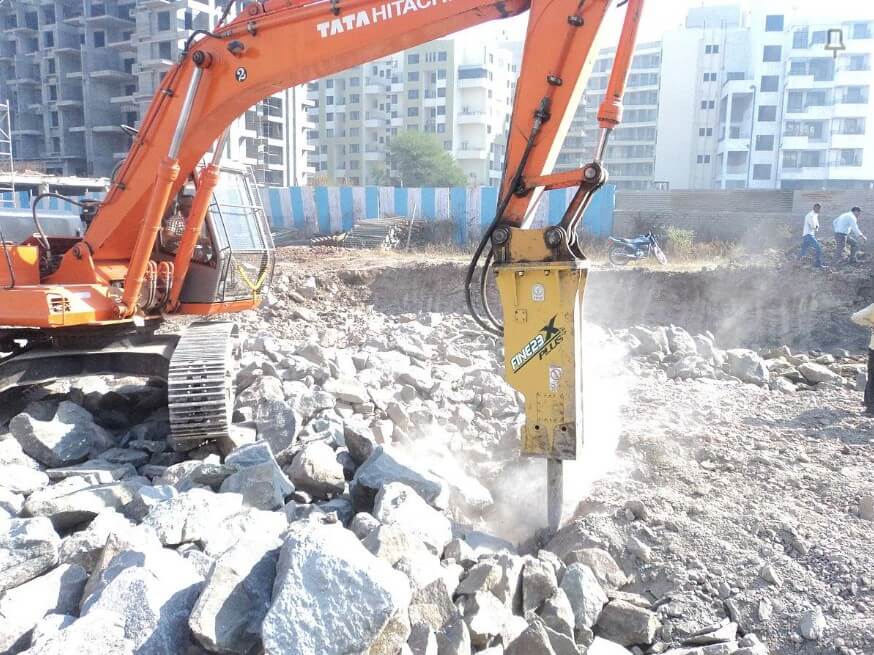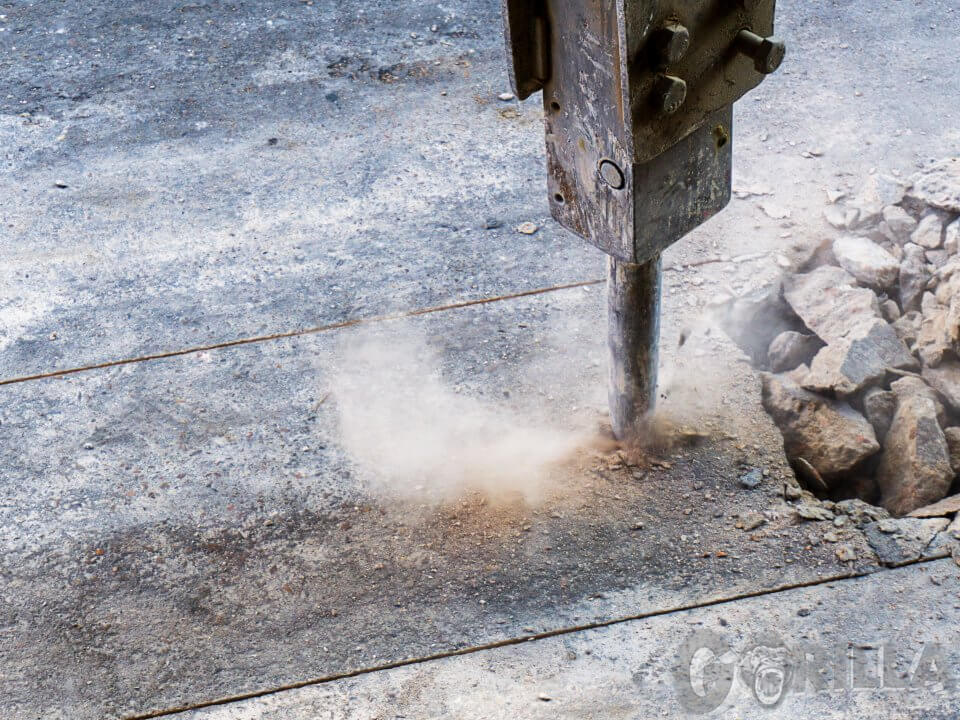
Maintaining Your Gorilla Hammer: Essential Maintenance and Care Tips
May 25, 2023
Protecting Your Hydraulic Cylinders from Impact and Chemical Damage
June 21, 2023At Gorilla, we get several calls each week with the same query: Why doesn’t my hydraulic breaker run?
Without going too deep or too far into detail, here are some basic hydraulic hammer troubleshooting tips to get you started on evaluating your hydraulic breaker repair.
Start with the carrier!
No hoe ram will run without the skid steer, mini-excavator, backhoe, or excavator putting the right amount of oil into it. No hydraulic hammer should ever be installed without a flow test to ensure oil is being supplied within the breaker’s specifications. Auxiliary hydraulic flow testing is explained in other blogs, but assuming that the carrier was properly flow tested during initial installation, here are some hydraulic breaker troubleshooting tips.
Check the shutoff valves or fluid couplers:
The hammer valves at the end of the stick tubes often wiggle shut from vibration if the levers are not locked in place. Fluid couplers/quick disconnects are often not completely coupled or are broken apart inside. Either of these conditions will reduce or prevent oil flow to the hydraulic hammer, not giving it enough power to cycle. Always make sure the hammer shutoff valves or fluid couplers-typically located at the end of the sick tubes-are “open”, allowing oil to flow freely. We “fix” a lot of hydraulic breakers over the phone with this advice.
Make sure the pressure and return lines for the breaker are connected to the carrier properly:
Check to make sure that the pressure line from the hydraulic hammer is going to the pressure side of the hoe ram, and that the return side of the breaker is hooked up to the tank return. A reversal of these auxiliary hydraulic lines can cause the breaker to run poorly or not at all. They are occasionally marked, but if they are not, the auxiliary hydraulic lines on most mini-excavators, backhoes, and crawler excavators typically exert pressure on the operator’s left and return to the operator’s right. If they are not marked, the operator can easily follow each auxiliary line back to the machine and see where it goes. The pressure line typically traces back to the auxiliary or priority valve, where the return line must return to the tank to run the hammer without overheating. If oil is returning to the valve stack, your hydraulic hammer will perform poorly, run hot, and wear out seals prematurely due to excessive backpressure.
It does not happen often with nitrogen-fired breakers like Gorilla, Kent/FRD, or NPK, but if fully hydraulic hammers with top accumulators-like Tramac / Montabert, Rammer, Indeco, and first-generation Caterpillars-are repaired and the power cell/ main body is placed in the outer body or frame backward, the breaker will not run. On these fully hydraulic hammers, the return side typically has a larger orifice on the return side and is often marked as an “outlet”. This hoe ram problem is typically noticed as soon as it comes back from the repair shop. In a pinch, the lines can just be “crossed” until the power cell/main body can be removed from its outer box/frame and re-installed properly.
Do a visual check of the outside of the hydraulic breaker:
Look closely at your breaker to look for broken fasteners. Most hydraulic hammers have tie rods, known to some as side bolts. These fasteners-typically four of them-run from the top to the bottom of the hydraulic breaker, and hold the backhead, cylinder, chuck housing/tool holder/ front head together. If one or more of these are broken, that can cause the three main components noted above to shift, and their misalignment can cause the piston to mechanically bind and stick in the bore, causing the hoe ram not to cycle.
Check nitrogen levels:
If the nitrogen level is too high-usually in a nitrogen-fired hammer, hydraulic pressure will not be able to lift the piston against the resistance of the top nitrogen chamber, also known as the back head. If you are properly trained in handling nitrogen chambers in hydraulic breakers, you can bleed some nitrogen out gradually, which will lower cycling resistance inside the hammer. Believe it or not, most hydraulic breakers will cycle without any nitrogen at all, and sometimes draining the back head down to nothing will rule out a mechanical bind. Of course, internal bypass from worn seals-like a bad set of rings in an internal combustion engine-will also decrease the ability of the hydraulic hammer to lift the piston.
Check for mechanical bind in the chuck housing/ tool holder/ front head of the hydraulic hammer:
Oftentimes, the hydraulic hammer demolition tool or the striking piston is broken. This can cause a mechanical bind that no hydraulic pressure can overcome. This is the most work, but removing the chisel tool bit to look up inside the hydraulic breaker will rule this out. BE CAREFUL! Broken pieces of the demolition tool bit or strike piston are super sharp, and people are often cut while running their hands up inside the chuck housing to perform this check.
Check the hoe ram’s shuttle valve/ piston shifting valve:
This is the least common cause and is the most involved hammer troubleshooting step. All hydraulic hammers have some type of valve or switching mechanism that changes the direction of the striking piston. When the striking piston is lifted under hydraulic pressure and reaches the top of its travel, this mechanism switches to exert a downward force on the piston to strike the demolition tool, which completes the cycle. If it is stuck or broken, the piston will not move at all or will be stuck in one direction. These valves/mechanisms are much harder to access in fully hydraulic hammers as they are located in the top head, but many nitrogen-fired breakers have an external valve that can be removed and checked for movement. Please note that this is an infrequent problem, and often involves some seals that may be disturbed during this hydraulic hammer repair procedure.
Covering every caveat in diagnosing a hydraulic hammer’s failure to cycle is too much for this forum. At Gorilla, we try to walk our customers through these basically free steps before they send theirs in for hydraulic breaker repair or hydraulic breaker service. The last resort is to disassemble the unit for a complete hydraulic breaker evaluation completely. If you rule these out and your hydraulic hammer does have to be torn down and examined, The Hammer Shop™ at Gorilla can help. We receive breakers from all over the country, with around 300 repairs performed each year. One of our Hammer Advisors™ can help you with the freight to get it here and make it easy to get your hoe ram back up and running.
Have more questions, Contact Gorilla Hammers
Troubleshooting hydraulic hammers doesn’t have to be a daunting task. Gorilla Hammers is your trusted partner in overcoming any hammer-related challenges. With expert tips, our blog equips you with the knowledge to tackle issues head-on. Contact us at (888) 814-6745 or sales@gorillahammers.com to learn more about our top-quality hydraulic hammer solutions. Trust Gorilla Hammers for reliable performance and productivity.



